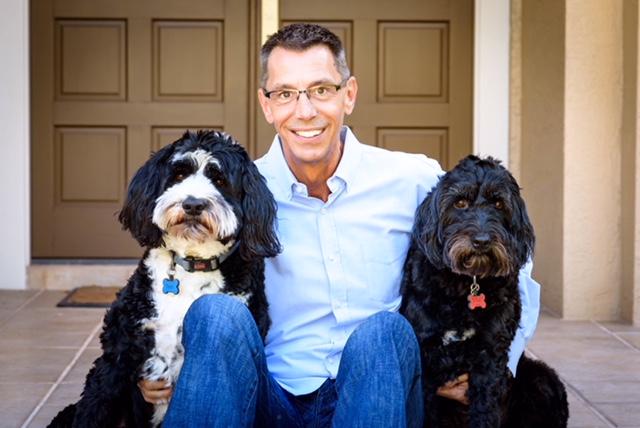Leaders often wonder, do I always need to be in front to lead? See how walking my dogs got me to thinking about that question…
I have two well-behaved Portuguese Water Dogs, Bella and Tazo. When I walk them, Bella is always on my left and Tazo is always on my right; never do the two overlap.

My neighborhood has sidewalks on an inner circle and an outer circle. Our walks always start out the same. We leave the house, turn right out of the driveway and onto the inner circle sidewalk.
However, there comes a point at a specific driveway half-way around the inner circle when I decide if we continue walking on the inner sidewalk for the shorter walk, or cross over to the outer sidewalk for the longer walk.
Until that point both dogs are slightly in front of me, happily walking and sniffing the grass. As soon as we approach that specific driveway, where I make the decision on the longer or shorter walk, they slow down and get slightly behind me as if they are saying “Ok Dad, you lead us where you want us to go.”
That got me to thinking how this act of them slowing down and getting behind me relates to leadership.
Why Leadership Matters
When employees don’t know which way to go or what to do, they will fall behind the leader looking for their leadership. Most believe that leaders must always be in front to lead. While that may be true in some circumstances, do you always need to be in front?
When walking the dogs, I’m always their leader, even if they are slightly ahead of me. Up to that specific point where the decision is made, they know what is expected of them to keep walking next to me on their assigned sides sniffing grass.
As a leader, if your employees know what is expected of them, they will do it and most likely do it well. Once they don’t know what to do or which way to go, they will need you to step in front to lead them.
What causes employees to not to know what to do or which way to go?
It could be they don’t know how to do what is expected of them because they haven’t developed the skill.
It could be a change in processes or strategy making them unsure of what to do and/or which way to go even if they have the skills.
That’s when a leader needs to get out front to lead. I have found in my experience as a leader and coaching many leaders that using the following leadership behaviors will position you in front to lead when you need to be there for your employees.
Communicate
Clearly communicate your expectations. This will remove any questions or doubts in your employees’ minds on what is expected of them in any situation. Explain to them how they will meet your expectations. Describe what’s in it for them, and the company, to meet your expectations.
When I get to that driveway and I decide that we are going to cross over to the outer sideway I say, “This Way” and tug lightly on their leashes in that direction. They follow my lead because they know that is what is expected of them.
Support
Tell your employees how you will support them to meet your expectations. Then do it. Demonstrate and/or coach them to develop their skills to meet your expectations.
Explain how you will hold them accountable to meet those expectations. Yes, that is the dreaded “A” word. If you don’t hold them accountable to meet your expectations even just once, then you have started to lose your effectiveness as a leader.
If Tazo or Bella decide they want to go to the outer sidewalk but I am not up for the long walk, I just redirect them with tugs on the leashes and say “This Way” while walking on the inner sidewalk, and they follow my lead.
Praise
Praise your employees for meeting your expectations. Tell them how their actions have had a positive impact on them, the company and customers (if applicable). When you praise an employee for good behavior, that reinforces that they will repeat those behaviors in the future.
That is how I got the dogs to line up on each side of me. I told them which side and demonstrated my expectations by holding the leash in that hand. When they lined up on that side I praised them for a job well done (of course the treats helped too!). Now I don’t have to even think about putting them on each side of me, they do it automatically because they know that is what I expect.
Build Trust
Leadership requires a strong foundation of trust. Your employees need to trust that you will always lead them in the right direction. You will earn their trust by proving that you will be with them every step of the way, guiding and leading them to be successful.
My dogs always know that I will bring them home, no matter which sidewalk we take on our walk. They trust me.
Leadership Conclusions
While offering leadership to employees is obviously more nuanced and complex than my leadership to Bella and Tazo, persistently and consistently exhibiting the leadership behaviors of Building Trust, Communicating Expectations, Supporting and Praising are always critical to being an effective leader.
Whether you’re in front, next to or slightly behind your employees, they will know that their leader is always there to lead them in the right direction when needed.



